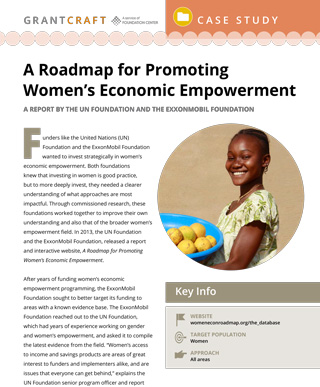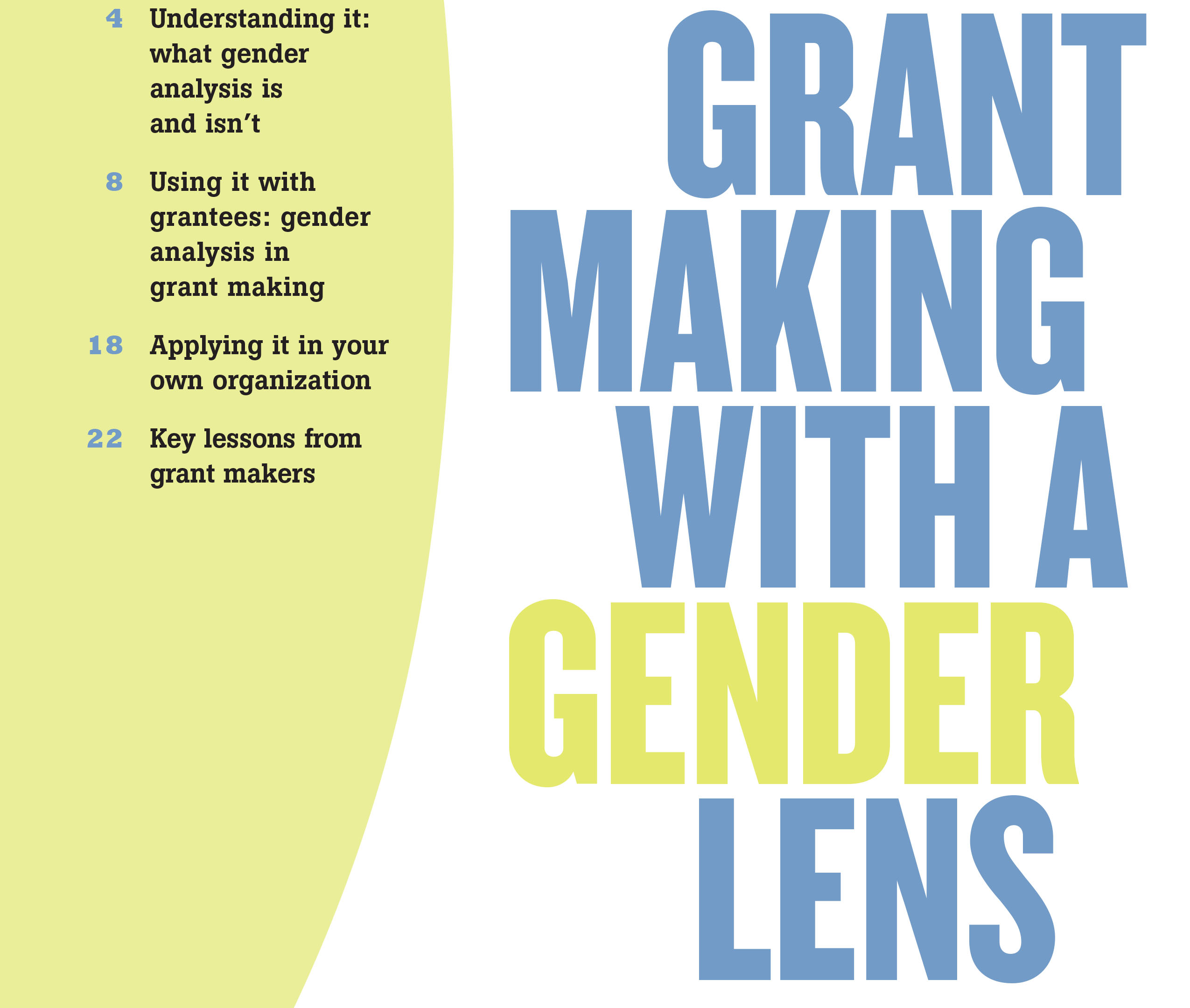A Roadmap for Promoting Women’s Economic Empowerment A Report by the UN Foundation and the ExxonMobil Foundation
Funders like the United Nations (UN) Foundation and the ExxonMobil Foundation wanted to invest strategically in women’s economic empowerment. Both foundations knew that investing in women is good practice, but to more deeply invest, they needed a clearer understanding of what approaches are most impactful. Through commissioned research, these foundations worked together to improve their own understanding and also that of the broader women’s empowerment field. In 2013, the UN Foundation and the ExxonMobil Foundation, released a report and interactive website, A Roadmap for Promoting Women’s Economic Empowerment.
After years of funding women’s economic empowerment programming, the ExxonMobil Foundation sought to better target its funding to areas with a known evidence base. The ExxonMobil Foundation reached out to the UN Foundation, which had years of experience working on gender and women’s empowerment, and asked it to compile the latest evidence from the field. “Women’s access to income and savings products are areas of great interest to funders and implementers alike, and are issues that everyone can get behind,” explains the UN Foundation senior program officer and report co-author, Rebecca Furst-Nichols. “We know that when women have more money, families and societies benefit, but the evidence to date has been weak in pinpointing the most effective ways to pursue this goal.”
In addition to informing their own strategies, both foundations wanted to provide other grantmakers with accessible information to approach women’s economic empowerment work more thoughtfully. A Roadmap for Promoting Women’s Economic Empowerment provides a macro-level framework to determine the most appropriate type of intervention based on the context and the profile of women targeted. Rebecca explains that the framework and the report were developed with global-level donors and practitioners in mind: those working from global capitals making investments across a range of contexts and types of beneficiaries do not have the detailed conceptual nuance of program implementers in the field. Yet, they make major investment decisions. The Roadmap is intended to steer those investments in an evidence-based direction.
 The project commissioned 18 research studies to help identify the most effective interventions to empower women economically. It then brought together more than 45 international experts from academic institutions, international agencies, and nonprofit organizations to analyze existing empirical evidence and generate new findings. Based on the commissioned studies, the project compiled a curated database of 136 published empirical evaluations of programs and policies. The database provides donors, researchers, and practitioners with the ability to sort through concrete examples of programs in different countries, their key findings, and links to the empirical studies. The goal was to identify the interventions that contribute to two key outcomes—increases in both women’s earnings and productivity—that could then inform future investments.
The project commissioned 18 research studies to help identify the most effective interventions to empower women economically. It then brought together more than 45 international experts from academic institutions, international agencies, and nonprofit organizations to analyze existing empirical evidence and generate new findings. Based on the commissioned studies, the project compiled a curated database of 136 published empirical evaluations of programs and policies. The database provides donors, researchers, and practitioners with the ability to sort through concrete examples of programs in different countries, their key findings, and links to the empirical studies. The goal was to identify the interventions that contribute to two key outcomes—increases in both women’s earnings and productivity—that could then inform future investments.
The final, publicly available report summarizes the findings of the commissioned research studies. It groups interventions into four main categories of women’s employment—entrepreneurship, farming, wage employment, and young women’s employment—and includes the Roadmap for Action, an interactive map that walks readers through options of proven, promising and high-potential program interventions based on the selected context and type of beneficiary. The research and final report aim to answer three main questions:
- What works? Which economic empowerment interventions are proven, promising or high-potential, based on the evidence from rigorous policy and program evaluations? One example: Access to savings products works for all women, and women invest their own savings into their businesses, in a way that they may not use credit.
- For whom? For specific categories of women likely to be working for pay or seeking work, which interventions were most effective? The key takeaway: Interventions must be adapted to the type of women being targeted. For example, single agricultural services, rather than a full suite, may be enough to increase productivity of women with larger sized farms, more assets, and more control over those assets, while an integrated suite of services, which target both production and address social constraints, is more successful in raising the productivity of small-scale women farmers.
- Where? How do typical country scenarios influence the success of interventions? The most important piece: Context. The “where” really matters, and so learning about it through literature, interviews, videos, and firsthand experience is critical. For example, research shows that in low-income, socially conservative settings, livelihood programs that combine reproductive health education with income and asset-building show promising results for young women.
Rebecca shares that although many funders may be looking for a silver-bullet approach to women’s economic empowerment, there is no such thing, especially when targeting very poor women. “If organizations really want to increase productivity and earnings for extremely poor women in any measurable way, they need to provide a bundle of services, such as combining an in-kind grant with intensive technical training.”
The Roadmap for Action tool was intended to move the philanthropy field forward by offering an easy-to-use framework for accessing this knowledge. Rebecca explains, “The findings from our process were that the field doesn’t have a streamlined way of thinking about how to choose interventions, and researchers don’t really look at a streamlined set of outcomes. The hope is that this framework will push the field to examine at least a minimum set of similar outcomes that drive toward a common body of evidence.” In light of these findings, the UN Foundation and ExxonMobil Foundation subsequently partnered to produce a set of common direct, intermediate, and final outcomes in their recent guidance note on Measuring Women’s Economic Empowerment. This note is intended for use by program evaluators as well as donors and implementers, and detailed metrics, guidelines, and questionnaires are available on their website.
This case study was developed for Foundation Center's Equal Footing project.




